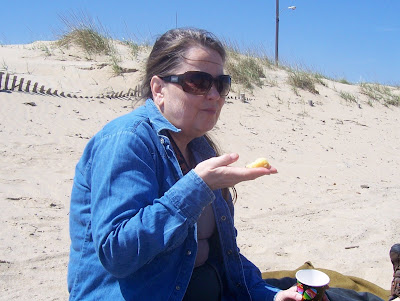
This recipe comes from Seattle chef Tom Douglas and can be found in his cookbooks and on-line at the
Fine Cooking site.
For the cake: Soft butter for the pan
6-3/4 oz.(1-1/2 cups) all-purpose flour
4-1/2 oz. (3/4 cup) finely ground yellow cornmeal (Quaker brand is fine)
1/3 cup coarsely chopped toasted pine nuts (about 1-1/2 oz.)
1 Tbs. finely chopped fresh rosemary
1 Tbs. finely grated orange zest
1 tsp. baking powder
1/4 tsp. kosher salt
5 oz. (2/3 cup) mascarpone, at room temperature
4 large eggs
10 oz. (1-1/3 cups) granulated sugar
1/4 lb. (1/2 cup) unsalted butter, melted
For the orange syrup:
1/2 cup fresh orange juice
3 Tbs. granulated sugar
For the orange glaze:
1 Tbs. whole fresh rosemary leaves (stripped from the stem but not chopped)
5 oz. (1-1/2 cups) sifted confectioners’ sugar
5 Tbs. heavy cream
2 Tbs. fresh orange juice
1 tsp. grated orange zest
Make the cake: Position a rack in the center of the oven and heat the oven to 350°F. Butter a 9x2-inch round cake pan, line the bottom with a round of parchment, and butter the parchment. In a medium bowl, whisk together the flour, cornmeal, pine nuts, rosemary, orange zest, baking powder, and salt. In a large bowl, briefly whisk the mascarpone to loosen it. Add the eggs one at a time, whisking to combine. Add the sugar and whisk until smooth. Using a rubber spatula, fold the dry ingredients, in two batches, into the wet ingredients, mixing until smooth. Stir in the melted butter with the rubber spatula until blended. Scrape the batter into the prepared pan, spread evenly, and bake until the entire top of the cake is a rich golden brown and springs back when pressed gently in the center, 40 to 45 minutes. A skewer inserted in the middle of the cake should come out looking a bit moist, and the sides of the cake may have begun to pull away from the pan.
Make the orange syrup: While the cake is baking, combine the orange juice and sugar in a small saucepan over medium heat and cook for a few minutes, stirring occasionally, until the sugar dissolves. Remove from the heat. Let the cake cool in its pan on a rack for 5 minutes. Run a small knife around the cake. Set an inverted plate over the cake pan and, protecting your hands with a kitchen towel, invert the whole thing. The cake should slide right out onto the plate. Peel off the parchment and set a 9-inch cardboard round or another inverted plate over the cake and, again, invert the whole thing. Remove the top plate and the cake will be right side up. With a wooden skewer or toothpick, poke a few dozen holes all over the top of the cake. While the cake is still warm, brush the cake with the warm orange syrup. Continue brushing for several minutes, giving the syrup time to sink into the cake, until you’ve used all the syrup. Let the cake cool completely.
Make the orange glaze: Bring a small saucepan of water to a boil. Have ready a small bowl of ice water. Put the rosemary leaves in a small sieve and dip it into the boiling water to blanch them for 1 minute. Drain the rosemary leaves and immediately set them (still in the sieve) into the ice water. Drain and spread the rosemary leaves on a paper towel to dry. In a bowl, whisk the confectioners’ sugar, cream, and orange juice until smooth and then whisk in the blanched rosemary and the zest.
When the cake is cool, transfer it to a rack set over a baking sheet. (If your cake isn’t on a cardboard round, use a wide spatula to transfer it.) Pour the glaze over the top of the cake and let it drip off the sides. You can gently tilt the cardboard or the wire rack back and forth to encourage the glaze to completely flow over the top of the cake. While the glaze is still wet, transfer the cake to a cake plate.
Let sit for an hour or more before cutting the cake into wedges and serving. The glaze may or may not become firm, depending on the weather; it’s delicious either way.
Make Ahead TipsYou can bake and glaze this cake the day you serve it. Or bake it a day ahead, brush it with the syrup, let it cool completely, wrap it in plastic, and store at room temperature. The afternoon before your dinner, glaze the cake.























